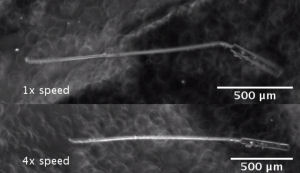
DNA and RNA possess two features believed essential for life: they display heredity (pass on genetic information) and they can adapt over time (Darwinian evolution). Now, scientists have shown that heredity and evolution can be performed by molecules other than DNA and RNA. Their findings, appearing in the current issue of Science, shed new light on questions concerning the origins of life and the possible future development of synthetic organisms.
Both RNA and DNA embed data in their sequences of four nucleotides – information vital for conferring hereditary traits and for supplying the coded recipe essential for building proteins. How this system bootstrapped itself into existence remains one of the most intriguing areas of biology.
One hypothesis suggests the simpler RNA molecule preceded DNA. The RNA world hypothesis proposes that the earliest examples of life were based on RNA and simple proteins. Because RNA is capable of carrying genetic information and catalyzing chemical reactions like an enzyme, it is believed by many to have supported pre-cellular life.
But the spontaneous arrival of RNA through a sequence of purely random mixing events of primitive chemicals is thought to be an unlikely occurrence. “This is a big question,” says researcher John Chaput of Arizona State University. “If the RNA world existed, how did it come into existence? Was it spontaneously produced, or was it the product of something that was even simpler than RNA?”
This pre-RNA world hypothesis has been gaining ground, largely through investigations into unnatural nucleic acid polymers (Xenonucleic acids, or XNAs), which could have acted as chemical stepping-stones to the eventual emergence of life. The new research strengthens the case that this may have occurred.
The researchers explained that while they can engineer XNA molecules with unique properties, in order for any of these exotic molecules to have acted as a precursor to RNA in the pre-biotic epoch, they would need to have been able to transfer and recover their information from RNA. “There’s a lot of chemistry that seeks to build alternative nucleic acids, and people have been modifying the bases, the sugars and the backbone, but what we were focusing on was the type of nucleic acid or polymers that would retain the ability to communicate with the natural DNA,” explained researcher Philipp Holliger, from the UK Medical Research Council’s Laboratory of Molecular Biology. To do this, specialized enzymes, known as polymerases are required.
Nature created DNA and RNA polymerases that are capable of reading, transcribing and reverse transcribing normal DNA and RNA sequences. For XNA molecules, however; no naturally occurring polymerases exist. So the researchers painstakingly evolved synthetic polymerases that could copy DNA into XNA and other polymerases that could copy XNA back into DNA. The experiments demonstrated that these unnatural DNA sequences could be rendered into various XNAs when the polymerases were fed the appropriate XNA substrates.
Using these enzymes as tools for molecular evolution, the team evolved the first example of an HNA aptamer through iterative rounds of selection and amplification. Starting from a large pool of DNA sequences, a synthetic polymerase was used to copy the DNA library into HNA. The pool of HNA molecules was then incubated with an arbitrary target. The small fraction of molecules that bound the target were separated from the unbound pool, reverse transcribed back into DNA with a second synthetic enzyme and amplified. After many repeated rounds, HNAs were generated that bound HIV trans-activating response RNA and hen egg lysosome, which were used as binding targets. “This is a synthetic Darwinian process,” Chaput explained. “The same thing happens inside our cells, but this is done in vitro.”
The study advances the case for a pre-RNA world, while also revealing a new class of XNA aptamers capable of fulfilling myriad useful roles. “We’ve been able to show that both heredity and evolution, which are really two hallmarks of life, can be reproduced and implemented in alternative polymers other than DNA and RNA,” Holliger concluded. “There is nothing ‘Goldilocks’ about DNA and RNA – there is no overwhelming functional imperative for genetic systems or biology to be based on these two nucleic acids.”
Related:
Discuss this article in our forum
Knocking on the door of life: Self-replicating RNA synthesized
Newly discovered non-coding genes control critical disease processes
DNA Shaped Nebula Observed At Center Of Milky Way
DNA surname profiling mooted in UK
















Comments are closed.